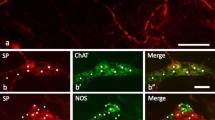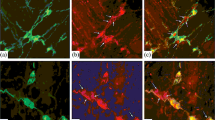Summary
A study was made of substance P-like-immunoreactive nerves within the small intestine of platypus, an Australian prototherian mammal. Both immunoreactive nerve cell bodies and fibres were present. No immunoreactive fibres were found in mesenteric nerves or on intramural blood vessels, suggesting that extrinsic sensory neurons containing substance P do not innervate platypus ileum. This was further supported by the result of in vitro experiments. Although applied substance P (10-9 M-3 × 10-8 M) caused contraction of the longitudinal muscle, neither mesenteric nerve stimulation nor application of capsaicin caused contractions.
Similar content being viewed by others
References
Barthó L, Holzer P (1985) Search for a physiological role of substance P in gastrointestinal motility. Neuroscience 16:1–32
Barthó L, Szolcsányi J (1980) The mechanism of the motor response to periarterial nerve stimulation in the small intestine of the rabbit. Br J Pharmacol 70:193–195
Barthó L, Holzer P, Lembeck F, Szolcsányi J (1982) Evidence that the contractile response of the guinea pig ileum to capsaicin is due to release of substance P. J Physiol 332:157–167
Bjenning C, Holmgren S (1988) Neuropeptides in fish gut. An immunohistochemical study of evolutionary patterns. Histochemistry 88:155–163
Björkroth U (1983) Inhibition of smooth muscle contractions induced by capsaicin and electrical transmural stimulation by a substance P antagonist. Acta Physiol Scand Suppl 515:11–16
Brodin E, Alumets J, Håkanson R, Leander S, Sundler F (1981) Immunoreactive substance P in the chicken gut: distribution, development and possible functional significance. Cell Tissue Res 216:455–469
Buchan AMJ (1986) An immunocytochemical study of regulatory peptides in the amphibian gastrointestinal tract. Can J Zool 64:1–7
Buchan AMJ, Polak JM, Pearse AGE (1980) Gut hormones in Salamandra salamandra. Cell Tissue Res 211:331–343
Buchan AMJ, Lance V, Polak JM (1983) Regulatory peptides in the gastrointestinal tract of Alligator mississippiensis. Cell Tissue Res 231:439–449
Campbell G (1988) Transmitter substances in the peripheral nervous system: an overview of the vertebrates. In: Owman C, Björklund A, Hökfelt T (eds) Handbook of chemical neuroanatomy. Elsevier, Amsterdam (in press)
Chahl LA (1982) Evidence that the contractile response of the guinea-pig ileum to capsaicin is due to substance P release. Naunyn-Schmiedeberg's Arch Pharmacol 319:212–215
Costa M, Buffa R, Furness JB, Solcia E (1980a) Immunohistochemical localization of polypeptides in peripheral autonomic nerves using whole mount preparations. Histochemistry 65:157–165
Costa M, Cuello AC, Furness JB, Franco R (1980b) Distribution of enteric neurones showing immunoreactivity for substance P in the guinea-pig ileum. Neuroscience 5:323–331
Costa M, Furness JB, Llewellyn-Smith IJ, Cuello AC (1981) Projections of substance P neurons within the guinea-pig small intestine. Neuroscience 6:411–424
Finkleman B (1930) On the nature of inhibition in the intestine. J Physiol 70:145–157
Furness JB, Costa M (1987) The enteric nervous system. Churchill-Livingstone, Edinburgh
Gabella G (1979) Innervation of the gastrointestinal tract. Int Rev Cytol 59:129–193
Gamse R, Molnar A, Lembeck F (1979) Substance P release from spinal cord slices by capsaicin. Life Sci 25:629–636
Gibbins IL, Furness JB, Costa M, MacIntyre I, Hillard CJ, Girgis S (1985) Co-localization of calcitonin gene-related peptide-like immunoreactivity with substance P in cutaneous, vascular and visceral sensory neurons of guinea pigs. Neurosci Lett 57:125–130
Hayashi H, Ohsumi K, Fujiwara M, Mizuno N, Kanazawa I, Yajima H (1982) Immunohistochemical studies on enteric substance P of extrinsic origin in the cat. J Auton Nerv Syst 5:207–217
Holmgren S (1985) Substance P in the gastrointestinal tract of Squalus acanthias. Mol Physiol 8:119–130
Holmgren S, Vaillant C, Dimaline R (1982) VIP-, substance P-, gastrin/CCK-, bombesin-, somatostatin-, and glucagon-like immunoreactivities in the gut of the rainbow trout, Salmo gairdneri. Cell Tissue Res 223:141–153
Holmgren S, Jensen J, Jönsson A-C, Lundin K, Nilsson S (1985) Neuropeptides in the gastrointestinal canal of Necturus maculosus. Cell Tissue Res 241:565–580
Jensen J, Holmgren S, Johnson A-C (1987) Substance P-like immunoreactivity and the effects of tachykinins in the intestine of the small intestine of the Atlantic cod, Gadus morhua. J Auton Nerv Syst 20:25–33
Maggi CA, Meli A (1988) The sensory-efferent function of capsacin-sensitive sensory neurons. Gen Pharmac 19:1–43
Maggi CA, Manzini S, Giuliani S, Santicioli P (1986) Extrinsic origin of the capsaicin-sensitive innervation of rat duodenum: possible involvement of calcitonin gene-related peptide (CGRP) in the capsaicin-induced activation of intramural non-adrenergic, non-cholinergic neurons. Naunyn-Schmiedeberg's Arch Pharmacol 334:172–180
Morris JL, Gibbins IL, Campbell G, Murphy R, Furness JB, Costa M (1986) Innervation of the large arteries of the toad (Bufo marinus) by adrenergic and peptide-containing neurons. Cell Tissue Res 243:171–184
Osborne P, Campbell G (1986) A pharmacological and immunohistochemical study of the splanchnic innervation of ileal longitudinal muscle of the toad Bufo marinus. Naunyn-Schmiedeberg's Arch Pharmacol 334:210
Rombout JHWM, Reinecke M (1984) Immunohistochemical localization of (neuro)peptide hormones in endocrine cells and nerves of the gut of a stomachless teleost fish, Barbus conchonius (Cyprinidae). Cell Tissue Res 237:57–65
Saffrey MJ, Polak JM, Burnstock G (1982) Distribution of vasoactive intestinal polypeptide-, substance P-, enkephalin- and neurotensin-like immunoreactive nerves in the chicken gut during development. Neuroscience 7:279–293
Schofield GC (1968) Anatomy of muscular and neural tissues in the alimentary canal. In: Code CF (ed) Handbook of physiology — alimentary canal. American Physiological Society, Washington DC vol IV, sect 6, pp 1579–1627
Yamada J, Krause WJ (19832) An immunohistochemical survey of endocrine cells and nerves in the proximal small intestine of the platypus, Ornithorhynchus anatinus. Cell Tissue Res 234:153–164
Yamada J, Matsuzaki K, Kitamura N, Yamashita T, Krause WJ (1985) An immunohistochemical survey of endocrine cells and nerves in the proximal duodenum of the echidna, Tachyglossus aculeatus. Z Mikrosk-Anat Forsch 99:209–218
Author information
Authors and Affiliations
Rights and permissions
About this article
Cite this article
Osborne, P.B., Campbell, G. & Evans, B.K. Distribution of substance P in the enteric plexuses of the small intestine of the platypus, Ornithorhynchm anatinus . Cell Tissue Res. 255, 663–667 (1989). https://doi.org/10.1007/BF00218806
Accepted:
Issue Date:
DOI: https://doi.org/10.1007/BF00218806




